Flight testing of the experimental aircraft Boom XB-1 began
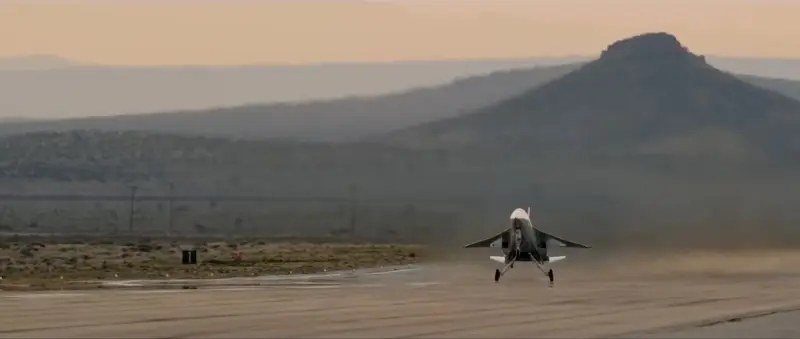
First takeoff of the XB-1
After several years of preparation, the American company Boom Technology (trademark Boom Supersonic) began flight testing of the experimental XB-1 Baby Boom technology demonstrator. With its help, it is planned to develop a number of new technologies and solutions, which will then be used in the Boom Overture full-size supersonic passenger aircraft project.
First time in the air
The first flight of the new prototype XB-1 aircraft took place on March 22, 2024. Mojave Airfield in California was chosen as the test launch site; the flight was carried out in the airspace above the desert of the same name. The development company notes the symbolism of this choice of testing site. It was in this airspace that in 1947 man first exceeded the speed of sound in horizontal flight.
Under the control of test pilot Bill Shoemaker, the prototype aircraft took off from the ground and took off for the first time. The flight was carried out along a closed circular trajectory in the area of the airfield. The flight duration did not exceed 20 minutes. For safety reasons, the pilot did not retract the landing gear. During the flight, the experimental vehicle was accompanied by a T-38 backup aircraft under the control of Tristan Brandenburg.
During the first flight, the experimental XB-1 showed some of its flight characteristics, and also demonstrated controllability and other parameters. According to the developer company, the aircraft rose to an altitude of 7120 feet (approx. 2150 m) and reached a speed of 238 knots (440 km/h). In all tested flight modes, the aircraft maintained stability and controllability. All onboard systems worked normally and helped the pilot control the aircraft.
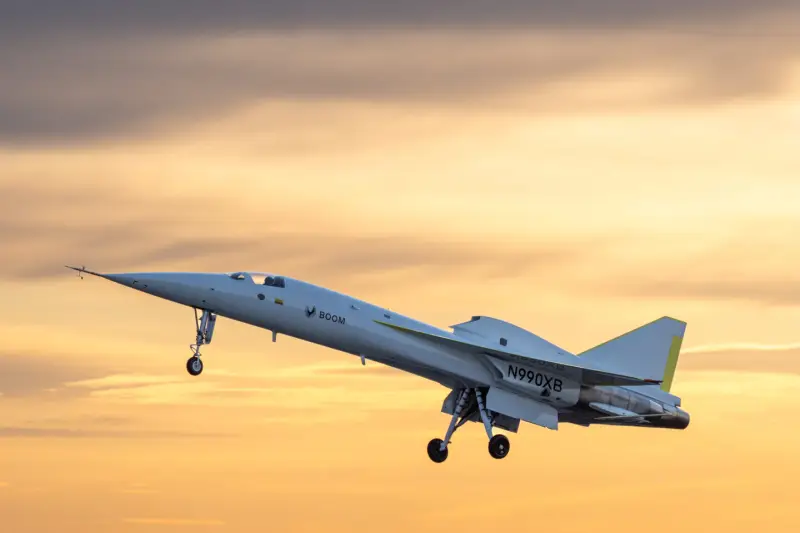
Baby Boom in the air
During the first flight, we also worked out a specific landing process. Due to special aerodynamics optimized for supersonic flight, the XB-1 must reach high angles of attack on the glide path. B. Shoemaker appreciated such features of the aircraft, and his comrade on the T-38 monitored the safety of the maneuver.
The first test flight of Baby Boom was considered successful. The experimental aircraft generally confirmed the designers' calculations and demonstrated the correctness of the technical solutions used. Now they are beginning to prepare it for the next test flights, which will help collect all the desired amount of information to continue the main Boom Overture program.
Following the results of the first flight of the XB-1, the management of the development company and test pilots made a number of statements - predictably joyful and optimistic. They highly appreciated the event and its significance both for the Overture project and for the passenger aviation generally. They also assured that new successes will follow in the very near future.
Complicated past
It should be noted that the joy of Boom Superonic employees is completely justified. They worked on the XB-1 and Overture projects for a long time, did not abandon them after a series of failures, and still received the desired intermediate result. At this stage, they can be praised for their zeal, but not yet for the result of the work.
The Boom Technology company was founded in 2014 and immediately set its goal to create a promising supersonic passenger aircraft (SPS). In 2016, it announced that before designing a full-fledged SPS, called Boom Overture, an experimental XB-1 aircraft would be created and tested. Its first flight was originally planned for the end of 2017.
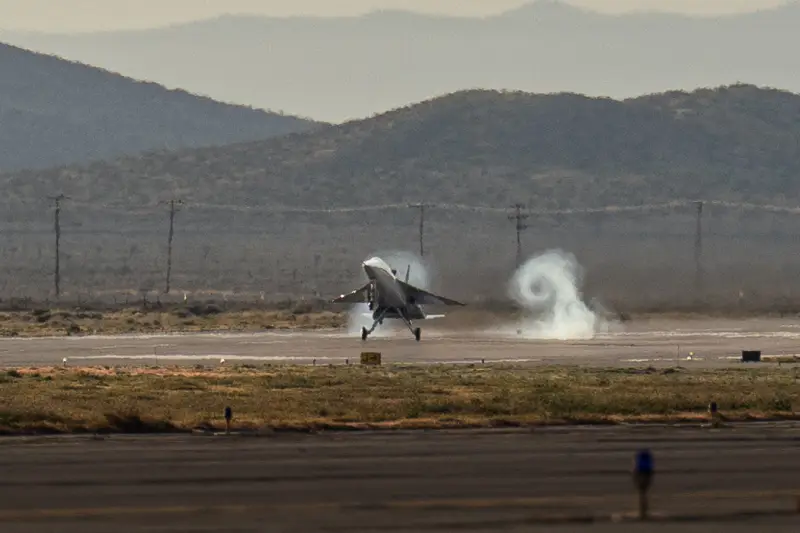
First landing
Boom Technology was not immediately able to find investors, which is why the work was hopelessly behind schedule, and the plans had to be revised. Thus, by the end of 2017, it was only possible to begin developing a full-fledged XB-1 project and manufacture the first components of the aircraft. Production of all airframe components was completed only in 2019-20. At the next stage, they were assembled into a single structure and equipped with the necessary units.
The finished prototype aircraft was rolled out of the assembly shop only in October 2020. In the coming months, they promised to conduct ground tests and move on to flight tests. The first flight was then planned for 2021, but without specifying the date. Difficulties arose again, and the start of flights was postponed again, now to 2022. As a result, the first flight took place only on March 22, 2024 - six to seven years later than the originally specified date.
Great future
Boom Supersonic reports that the experimental XB-1 coped with the tasks of the first flight and showed the required flight data, incl. maneuverability and controllability. However, several more subsonic flights are planned at different speeds and altitudes. After this, preparations for the next tests will begin.
At the second stage of testing, Baby Boom will show its supersonic potential. It will be tested at speeds up to M=2,2 throughout the entire design altitude range. It has not yet been specified when supersonic flights will begin. However, apparently, their program has already been drawn up. In particular, it is reported that T. Brandenburg will drive the car in these tests.
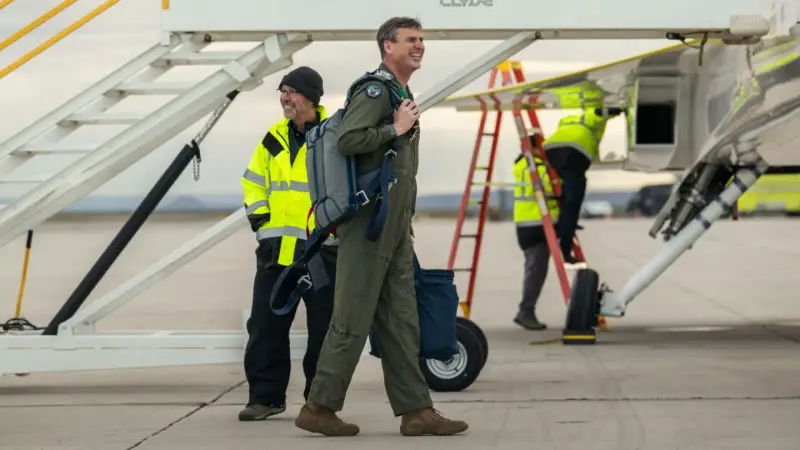
Test pilot Bill Shoemaker
In the future, XB-1 will help collect all the information about the operation of the structure as a whole and its individual units. Based on these data, the final version of the Boom Overture ATP will be developed. For obvious reasons, they cannot yet say how soon this project will be completed and brought to testing. Moreover, considering history technology demonstrator, one may doubt the very possibility of implementing the Overture project in a reasonable time frame.
Advanced technologies
The XB-1 Baby Boom experimental aircraft is designed to test all the core ideas of the Boom Overture concept that defined its design. The aerodynamic appearance, layout solutions, technologies and materials are borrowed from the full-size SPS project, but implemented on a reduced scale.
With the help of a technology demonstrator, they plan to test the proposed aerodynamic design in the air. The aircraft has an elongated spindle-shaped fuselage and a low aspect ratio wing with an ogival leading edge, a traditional tail unit and a propulsion system in the rear fuselage. In its aerodynamics and layout, the XB-1 differs from the real SPS of the past, but due to this it is planned to obtain certain advantages.
It is expected that the selected aerodynamic design will improve the basic flight performance and economic characteristics of the aircraft. The supersonic shock wave is expected to decrease and impact on ground objects. According to calculations, the experimental XB-1 should be several times quieter than the full-size Concord aircraft. It is also distinguished from serial SPS by the absence of a movable nose cone.
The airframe of the aircraft is made using metals and composites widely used in aircraft construction to reduce the cost and complexity of production. Materials are used that correspond to the calculated mechanical and thermal loads. A cooling system for the hottest elements of the airframe due to fuel circulation has also been implemented.
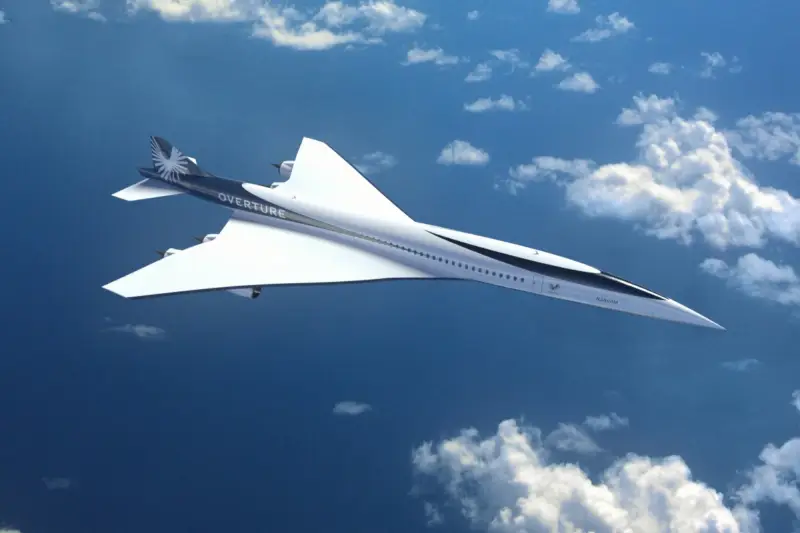
ATP Boom Overture concept
The XB-1 has a standard set of avionics for piloting that meets civil aviation standards. New solutions related to the specific design of the ATP have also been applied. Thus, special video systems are provided for forward and downward viewing without interference from the nose cone.
The experimental “Baby Boom” has a length of 21 m and a wingspan of 5,2 m. The take-off weight is 6,1 tons. Only one pilot fits in the cabin, and the free volumes are given over to control and recording equipment for recording test results.
The future Boom Overture will be many times larger and heavier. Its length will reach 50 m with a wingspan of 18 m. The take-off weight of 75 tons will allow it to carry up to 45-50 passengers. The speed characteristics of a full-fledged SPS will be at the level of the current technology demonstrator, and they want to increase the maximum range to 8,3 thousand km.
Place in the market
SPS Tu-144 and Concord at one time did not perform well, and in the end they were abandoned. Nevertheless, attempts to revive supersonic passenger aviation continue. New projects of such equipment are being created, devoid of the shortcomings of serial machines of the past. Some of them, incl. XB-1 Baby Boom enters flight testing stage as technology demonstrator aircraft. It is quite possible that in the future all this will lead to the emergence of new full-fledged ATP projects and even the start of their operation.
Boom Technology believes there are approx. 500 routes on which Overture-type aircraft can be used. To service them, up to 2 thousand aircraft will be needed. This is a fairly large market for which aircraft manufacturers will fight. Boom Technology wants to participate in such competition and have an advantage over other aircraft manufacturers. And its chances in the future SPS race directly depend on the testing of the experimental XB-1 that has begun.
Information